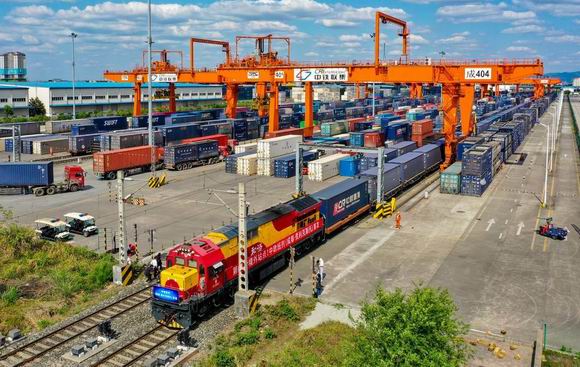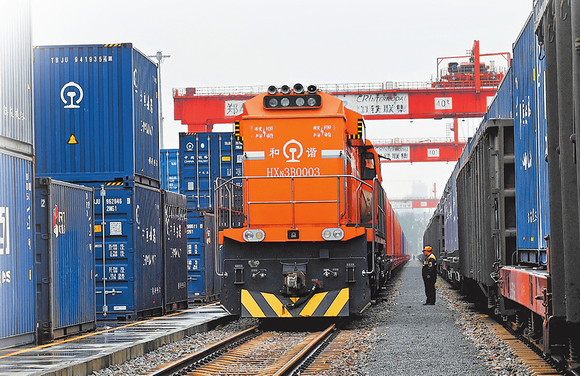
International China-Europe train transport, whose English name is "CHINA RAILWAY Express", abbreviated as" CR Express"", is an international intermodal train organized by China Railway Corporation.At present, the Central European Banquet has laid out 80 operating routes, reaching 255 cities in 23 European countries.
International railway (Central Europe-Asia train, FCL, LCL, end-to-end distribution)
International China-Europe train transport, whose English name is "CHINA RAILWAY Express", abbreviated as" CR Express"", is an international intermodal train organized by China Railway Corporation.At present, the Central European Banquet has laid out 80 operating routes, reaching 255 cities in 23 European countries.
There are three main channels:
The western passage is from the central and western part of China through Alashankou (Horgos).
The Central Passage leaves the country from North China via Erlianhot.
The eastern passage is from northeast China through Manzhouli (Suifenhe).
In addition, in recent years, the role of China-Europe trains in connecting logistics between China and Europe has been further highlighted. After leaving the country through railway ports such as Alashankou in Xinjiang, Erlianhot in Inner Mongolia and Manzhouli in Inner Mongolia, many routes continue to travel to Europe through Kazakhstan, Russia, Belarus and Poland.
The China-Europe train has become a new mode of international transport organization with convenience, security, stability and green economy, which has played an important role in deepening the economic and trade cooperation between the country and the countries along the line and promoting the construction of "one belt and one road".It has also promoted win-win cooperation on the Eurasian continent and brought new opportunities for the development of important border crossings and cargo distribution centers in Poland, Germany, Kazakhstan and other countries.
The main routes of the China-Europe train, which terminate or depart from major cities in China, are as follows:
Yiwu – Duisburg, Germany – Malashevich, Poland – Minsk, Belarus – Moscow, Russia
Hanxin - Europe line: Wuhan – Malashevich, Poland – Hamburg/Duisburg, Germany – Moscow, Russia
Chengdu-Europe Express: Chengdu - Lodz, Poland - Nuremberg, Germany - Tilburg, the Netherlands - Moscow, Russia
China-Russia freight train
The Chinese and Russian trains mainly travel between China and Russia and play a decisive role.At present, the regular shipping stations of Sino-Russian trains include Chengdu, Chongqing, Xi'an, Guiyang, Wuhan, Zhengzhou, Yiwu, Guangzhou, Shenzhen, Shandong, Shijiazhuang, Harbin and Shenyang.The main destinations include Moscow, St. Petersburg, Yekaterinburg and other important cities.Moscow is the capital of Russia and a major city in the country, as well as the capital of the Central Federal District; St. Petersburg is the second largest city in the country, known as the "Capital of the North", the capital of the Northwest Federal District, and also a comprehensive industrial center located on the Baltic Sea coast;Yekaterinburg, the capital of the Ural Federal District, is the third largest city in the country in terms of economy and population, and is located at the junction of Europe and Asia.
The advantages of China-Russia freight train liner transport services are mainly reflected in the following aspects:
1. Time advantage: Compared with sea transportation, the transportation time of China-Russia train is shorter.For example, the "China-Russia Express Line" from Harbin can greatly shorten the transportation time of goods when it leaves the country and enters Russia through Manzhouli Port.In addition, the road transportation of China-Russia land transportation line through Heilongjiang Province and the Russian Far East may be affected in winter, and the transportation time of this line is relatively short.
2. Transportation volume advantage: Compared with air transportation, the freight weight of the China-Russia train is more, and the transportation time is faster than that of sea transportation.Especially when the railway and shipping space is tight, it is a good choice to choose the China-Russia train.
3. Price advantage: The door-to-door price of the China-Russia train is almost the same as that of sea transportation, but the transportation time is shortened by half.This makes the China-Russia train very competitive in the international logistics market.
4. Stability: Against the backdrop of congestion and delays at major ports around the world, as well as the disruption of global shipping, the safe, stable and efficient transport advantages of the China-Europe freight train are further highlighted.This is important for the safety of goods and customer satisfaction.
5. Wide coverage: In recent years, with the rapid development of bilateral trade between China and Russia, the service routes of the train between China and Russia have been diversified to better serve the economic and trade cooperation between the two countries.
Central Asia train
The Central Asian train mainly travels between China and other Central Asian countries, and the main destinations served by the Central Asian train include Kazakhstan, Uzbekistan, Kyrgyzstan, Tajikistan and Turkmenistan.In addition, these trains also pass through or connect West Asia, South Asia and other regions.In order to provide more comprehensive services, the Central Asian train departs from various cities in China, including Tianjin, Xi'an, Jinan, Hefei, Lianyungang, Zhengzhou, Wuhan, Jiaozhou, Guangzhou, Chengdu and Lanzhou.Such a network layout enables the Central Asian Banquet to better serve the economic and trade cooperation between China and Central Asian countries.
The advantages of the Central Asia train are mainly reflected in the following aspects:
1. Time advantage: Compared with sea transportation, the transportation time of the Central Asia train is shorter.It also takes less time to transport than air freight and does not involve quarantine of personnel.For example, as of May 30, 2021, the number of trains in Central Asia has exceeded 3000, and nearly 1.2 million tons of cross-border cargo have been transported.
2. Price advantage: The freight rate of the Central Asian freight train is only one fifth of that of the air freight train, which has a significant price advantage.This makes the Central Asian train very competitive in the international logistics market.
3. Stability: In the context of congestion and delays in major ports around the world and the obstruction of global shipping, the advantages of safe, stable and efficient transport of Central Asian trains are further highlighted.This is important for the safety of goods and customer satisfaction.
4. Wide coverage: The service routes of the Central Asia train have been continuously expanded, and the fast transport corridors between China and Vietnam, Cambodia, Laos, Turkmenistan and other countries have been opened.This enables the Central Asian Banlie to better serve the economic and trade cooperation between China and the countries of the Central and South Peninsula.












